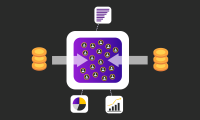Know All About The Top Ad Tech Trends of 2023
In this fast-paced, tech-driven world, trends either have a short shelf-life or go on to define the stream of the digital revolution. In the ad tech industry, trends are important. They signify the direction of ongoing events, as well as, growth. This decade can be identified as the defining period in the evolution of the ad tech industry. As 2023 has commenced, publishers in the ad tech industry must roll up their sleeves and come in with full force to latch onto some of the most reforming and impending ad tech trends.
- Elimination of third-party cookies
It’s true! Cookies are getting phased out. In an attempt to encourage targeting advertising and protect user privacy, Google made an announcement in 2020 that it will remove third-party cookies from Chrome by 2022. But according to recent news, the elimination has been delayed till the end of 2023.
The purpose of cookies is to store the data of user activities such as website visits on the browser. It’s a win-win for all. The websites can use cookies to track the user’s movement on the internet and provide them with a more customized experience. Advertisers use cookies to target their customers and show them relevant ads. However, after 2023, they will not have the support of third-party cookies.
There is a possibility that small and medium-sized businesses may face difficulty to target and retarget ads as they will not have reliable means to track data online. This may not be a problem for giants such as Netflix, Vodafone, and Apple who can rely on their first-party cookies. In fact, they began using their first-party data years ago Google announced the withdrawal of the cookies.
So, in the near future, we are most likely to see two things: users having a more private online surfing experience and the arrival of alternatives for third-party cookies.
- Contextual targeting
Speaking of alternatives for third-party cookies, contextual targeting is burgeoning. Contextual targeting or advertising is a method used by marketers that relies on contextual analysis algorithms to understand the history, performance, and content of the website they want to publish their ads. The reason why they can be the apt alternative for third-party cookies is that instead of following the user’s activity to show them ads, contextual targeting is about publishing ads on relevant sites.
Unlike third-party cookies, contextual targeting is niche and content-based. For instance, with third-party cookies, if a user has searched buying a carpet, then they are bound to see ads related to the carpet no matter which website they visit on the internet. Whereas in the case of contextual targeting, an ad about a carpet would be displayed on a home decor blog- a niche much related to the product.
Contextual targeting is also approved as an effective brand safety practice as it does not compromise the user’s data privacy. However, not many small or medium-sized advertisers are aware of this technique. But this year, contextual targeting is expected to garner momentum and become more ubiquitous.
- Rise of social commerce
Social commerce is revolutionizing the shopping experience and the e-commerce industry. It allows purchasing any products and services that happen within the social media platforms without moving to any other online platform. In 2023, social media apps are more versatile than ever and at the center of a user’s daily activities including checking news, staying connected, working, entertainment, and of course, shopping. With the increased consumption of social media apps, we can expect to see a significant rise in social commerce.
In 2020, Facebook, Pinterest, and Instagram launched social commerce tools that enable businesses to create digital storefronts on the platform. Brands can execute shoppable posts organically and further promote them through paid advertising. Social commerce is going to change mobile shopping in the next few years.
Brands can offer their social media community a streamlined shopping experience. With social commerce, it is easier for them to drive sales by offering features such as easy shopping navigation, detailed product descriptions, easy payment options, and all of that without navigating to any other site. In an attempt to make the shopping experience more immersive, brands are also using Live Shopping. Livestream shopping makes it easier for consumers to know the products better and get real-time answers to their questions.
- CTV Advertising
We have moved on from cable and satellite connections to CTVs. Hence, it’s time to also move on from TVCs to CTV advertising. Publishers need to be where their audience is. Streaming Boxes including Apple TV, Amazon Fire TV, and Samsung Allshare Cast are one of the leading and most successful CTV advertisements. A report by Interactive Advertising Bureau (IAB) says that CTV ad spending is expected to grow by 14.4% in 2023. A survey by Forbes suggests that it is the fastest-growing video advertising platform.
Connected TV advertising, or CTV advertising, allows brands to reach their audience on smart TVs and OTT devices. MNTN Performance TV gives brands the power to target their audience with Connected TV ads during premium, ad-supported shows provided by top-tier networks.
- Metaverse
What we once knew as a plot of a science fiction literary or cinema is now our reality. Metaverse has gained popularity this year, hence, it’s still fairly new. But 2023 will catapult its future and we can expect to see more in 2023. A lot of the giants in the market have already accepted the metaverse as the new marketing channel. The most common presentation of virtual worlds that we have experienced is in the gaming industry. It has also flourished in industries such as fashion, real estate, healthcare, and finance. Here’s what publishers can expect in the span of one year.
- Businesses will set up their own metaverse platforms or tools.
- Products will be showcased or advertised in virtual simulations.
- Virtual testing of products or experiments will be prioritized over physical testing.
- A decentralized metaverse will soon be mainstream.
- Image Streaming
We have already witnessed the power of streaming in the ad tech industry and its impact on the audience. This year, alongside video and audio, image streaming has held a promising position. This streaming technology is going to curb online image theft, propagation of fake use, plagiarism, etc. In 2023, publishers can surmount these issues with image streaming that comes with unique embedded links and are password protected. This technology makes images highly interactive and engaging with features like hyper zoom. Here are some more benefits of image streaming:
- Publishers can track the analytics of the image using the embedded link.
- Other users cannot screenshot or drag and drop the image.
- Publishers can control the visibility of the image from their platform through the central server.
- It offers incremental yield through contextual advertising within images.
Following trends is a means of adaptation
The acceleration of innovation and evolution has impacted consumer behavior and market trends. Publishers should adhere to these trends in 2023, make them their own, and emerge as industry leaders. What begins with trend spotting is followed by a long-term commitment to researching, improvising, and consistently delivering. It is crucial to look at reliable data and analyze future market trends. Publishers should identify their goals and use these trends to drive both quantitative and qualitative results.




Leave a Reply